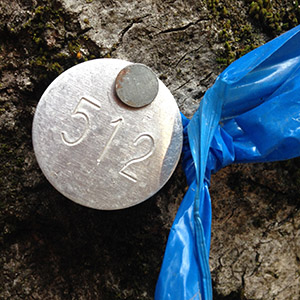Download sod map mobile and tap the risk button. If the risk shows up as high or moderate, call an arborist listed at http://www.suddenoakdeath.org/diagnosis-and-management/arborists-applicators/. If you get an insufficient data response, then see if you have any CA bay laurel trees within 20 yards of the oak. If you find any, do they have possible P. ramorum (pathogen that causes sudden oak death) symptoms (symptomatic photos: http://www.suddenoakdeath.org/library/photos/plant-symptom-photos/; host information: http://www.suddenoakdeath.org/diagnosis-and-management/hosts-and-symptoms/). If you do find questionable symptoms on bay, again, call an arborist listed at http://www.suddenoakdeath.org/diagnosis-and-management/arborists-applicators/ for a site visit.
If a homeowner suspects SOD is affecting their trees, there are a few options to get them tested. SOD kills several oak species and tanoaks, but it is primarily spread via infected California bay laurel leaves. Parties interested in testing for the presence of SOD can contact their local UC Farm Advisor or county Department of Agriculture to find out if they accept symptomatic bay laurel leaves for testing. (Go to Hosts and Symptoms on the California Oak Mortality Task Force [COMTF] website to learn what symptomatic bay leaves look like.)
Another option is to participate in a spring SOD Blitz. These are community-based, volunteer sampling efforts that are organized in cooperation with the Garbelotto lab. Training dates and locations are posted February 1st of each year for the upcoming sampling season at www.sodblitz.org. Training and sampling take just over an hour each and happen on the same scheduled weekend.
For infected oaks, call an arborist. A list of arborists that have attended a SOD training within the last 3 years is available on the Arborists and Applicators page of the COMTF website. NOTE: This list is only intended to be an additional filter for those looking for an arborist. It is not a list of recommended professionals.
There is no research or other observational evidence to indicate that glyphosate application increases Phytophthora ramorum infection. In mixed-evergreen and redwood forests some land managers use glyphosate to control invasive weeds, such as French broom, poison oak, and other problematic weeds. In coastal CA, these forest types contain coast live oak, California bay laurel, tanoak, and other plants susceptible to P. ramorum, but the disease is not known to spread or intensify due to glyphosate treatment.
Precautions. Always follow pesticide label instructions and consider non-pesticide alternatives to control pests. Pesticides can be injurious to humans, domestic animals, desirable plants, fish, and other wildlife if they are not handled or applied properly. Use all pesticides selectively and carefully. Follow recommended practices for the disposal of surplus pesticides and pesticide containers.
Oak testing is routinely done by arborists. It is a rather involved and tedious process that requires a fair amount of finesse and know how as it entails wounding the tree by shaving off the outer layer of bark to collect infected tissue. If you decide to have your oaks tested for SOD, consider going to the Trained Professionals List for arborists that have recently attended an official SOD seminar (Not intended to be a list of recommended professionals, this list does serve as an additional filter when trying to identify arborists that are up-to-date on the latest science-based SOD information.).
Alternatively, a less invasive method of determining the presence or absence of SOD on your property is to sample symptomatic bay leaves (See Hosts and Symptoms for SOD symptoms.). Keep in mind that any infested bay in the general vicinity (typically within 200 ft of an infected oak) may be the inoculum source for infection of your coast live oak. If bay sampling is your preferred method for pathogen detection, you can call your local UC Cooperative Extension office to find out if the California Department of Food and Agriculture is processing leaves from your county and, if so, what the protocol is for sample submissions. In lieu of submitting samples through your county, you can go to www.sodblitz.org to find out when a SOD Blitz will be held in your region (Dates for each year are posted by January 30th. Blitzes typically occur from March to June). Attending a blitz will afford you the opportunity to learn more about SOD, including the latest disease control strategies, during a 1-hour training session. At the end of the session you will be given all sampling materials and instructions for submissions. Blitz participants are free to submit as many leaves as necessary, meaning that you can send in all suspicious leaves from your property as well as from the neighborhood or nearby local parks. All leaves are processed at UC Berkeley and all sampling results are published in a database available at www.sodmap.org or through the free App SODmap mobile.
Although there may be few insects flying in the winter, the wet winter season (actually fall through spring) is a prime time for production of fruiting bodies by many wood decay fungi. The combination of fresh pruning wounds (especially large wounds), high spore densities of wood decay fungi, and moist conditions (favoring spore germination) can favor new infections by these fungi. From the standpoint of reducing risk of infection by wood decay fungi, pruning in late spring or early summer is probably preferable.
In general, pruning live branches from mature oaks should be kept to a minimum. However, if it is necessary to prune coast live oak branches, as long as they are less than 4″ in diameter, the presence of SOD is not a concern. Though, it is important to prune the oak correctly.
• Make sure you prune right where the tapering of the branch ends from the main stem or even slightly closer to the stem (1/2 in. from the end of the tapering towards the stem).
• Make sure the cut is clean and allows for water to drip without accumulating.
Tree removal is most likely required if the tree is a hazard to property, people, or places where people congregate (paths, camp grounds, etc.) Bear in mind that individual limbs may be more of a hazard than the failure of the entire tree. A certified arborist should be consulted to determine whether tree removal is needed. Proper pruning, fertilizing, and watering of ornamental trees may improve the overall health of your trees and reduce the likelihood of removal.








